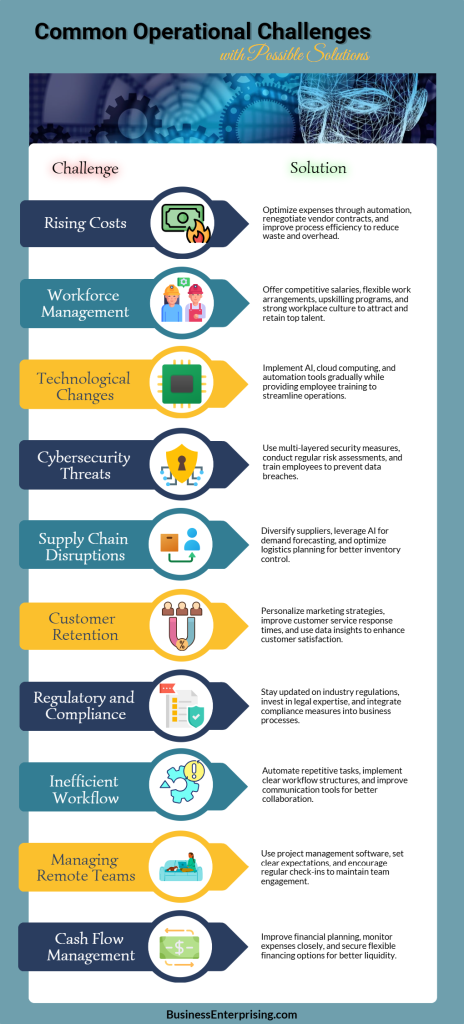
Technology is reshaping how businesses operate. AI, automation, and cloud solutions help streamline processes and improve decision-making. However, integrating new technology requires planning, training, and financial investment. Companies that embrace innovation can reduce costs, improve productivity, and strengthen customer relationships.
Managing employees is another challenge. Attracting and retaining top talent requires competitive wages, flexible work options, and career development opportunities. Additionally, maintaining a positive work environment boosts employee satisfaction. Businesses that prioritize their workforce create stronger teams and higher productivity.
Supply chain disruptions and cybersecurity threats also impact operations. Delays in materials or security breaches can harm reputation and revenue. However, improving risk management and data protection strategies can prevent major losses. Businesses that plan ahead can avoid costly disruptions and maintain customer trust.
Managing Rising Operational Costs
Rising operational costs continue to challenge businesses across industries. Inflation, supply chain disruptions, and labor costs are driving expenses higher. As a result, companies must find ways to manage spending without sacrificing productivity or customer satisfaction. Identifying cost-saving opportunities can help maintain profitability in a competitive market.
Supply chain issues have made it harder to secure materials at stable prices. Additionally, unpredictable shipping costs add pressure to budgets. Businesses that rely on imported goods may face delays and higher fees. Therefore, diversifying suppliers and using local sources can help reduce risks and control expenses.
Labor costs are also increasing as companies compete for skilled workers. Higher wages and benefits are necessary to attract and retain employees. However, automation can reduce reliance on manual processes and improve efficiency. By investing in AI-powered tools, you can streamline repetitive tasks and focus on growth.
Process optimization is another way to control costs. Analyzing workflows helps identify inefficiencies and areas where resources go to waste. Additionally, reducing energy consumption and renegotiating vendor contracts can lower expenses. Making small adjustments to daily operations can lead to significant savings over time.
Challenges in business operations require proactive solutions. By adopting cost-saving strategies, you can strengthen your company’s financial stability. Monitoring expenses, improving efficiency, and leveraging automation can help you stay ahead. Finding the right balance between cost reduction and productivity ensures long-term success.
Workforce Management and Employee Retention
Hiring and retaining top talent remains a challenge for many businesses. Increased competition, shifting employee expectations, and skills gaps make workforce management more complex. Additionally, high turnover rates can disrupt productivity and increase hiring costs. Finding effective strategies to attract and keep employees is essential for long-term success.
Many job seekers prioritize flexibility when considering new opportunities. Remote work options and hybrid schedules can improve work-life balance and job satisfaction. Additionally, offering competitive benefits helps attract skilled professionals. Providing healthcare, retirement plans, and wellness programs can increase retention and improve overall morale.
Training and development programs also play a key role in keeping employees engaged. Upskilling allows workers to grow within the company and take on new responsibilities. Additionally, mentorship programs can create a strong support system and improve job performance. Investing in employee growth can reduce turnover and increase loyalty.
Workplace culture affects retention as well. A positive environment with open communication encourages employees to stay long-term. Additionally, recognizing achievements and offering career advancement opportunities can boost motivation. Small efforts to improve job satisfaction can make a significant difference in workforce stability.
Challenges in business operations often stem from poor workforce management. By offering flexibility, competitive benefits, and professional development, you can attract and retain top talent. A strong workforce leads to better productivity, reduced hiring costs, and long-term business growth.
Adapting to Technological Changes
Keeping up with technological changes presents challenges for many businesses. Rapid advancements in AI, cloud computing, and automation require constant adaptation. However, implementing new technology often comes with costs, training requirements, and integration issues. Businesses that fail to modernize risk losing efficiency and falling behind competitors.
Many companies struggle with outdated systems that limit growth. Transitioning to cloud solutions can improve scalability and reduce infrastructure expenses. Additionally, cloud-based platforms enable remote access, making collaboration easier. However, shifting to new systems requires careful planning to avoid disruptions. Investing in training helps employees adopt new tools more effectively.
Automation is transforming business operations by reducing manual tasks and improving productivity. AI-powered tools streamline customer service, data analysis, and workflow management. Additionally, automated processes lower costs and minimize errors. However, businesses must choose solutions that align with their needs to maximize benefits.
Keeping up with digital trends requires ongoing investment in technology and training. However, many businesses hesitate due to concerns about costs and complexity. A phased approach can help ease the transition and minimize risks. Additionally, working with technology partners can provide expert guidance and support.
Challenges in business operations often stem from outdated technology and inefficient processes. By embracing AI, cloud computing, and automation, you can improve efficiency and drive growth. Staying ahead of digital trends ensures long-term success in an increasingly competitive market.
Ensuring Strong Cybersecurity and Data Protection
Cybersecurity threats continue to rise, putting businesses at risk of data breaches and financial losses. Hackers target sensitive information, leading to stolen customer data and operational disruptions. Additionally, new regulations require companies to follow strict security measures. Failing to comply can result in penalties and reputational damage.
Many businesses struggle to keep up with evolving threats. However, implementing a multi-layered security approach can reduce risks. Strong firewalls, encryption, and endpoint protection help safeguard data. Additionally, regular system updates close security gaps that attackers often exploit. Investing in advanced security tools strengthens defenses and minimizes vulnerabilities.
Employee training also plays a key role in preventing cyberattacks. Phishing scams and weak passwords often lead to breaches. However, regular security awareness programs can help employees recognize threats. Additionally, requiring multi-factor authentication adds another layer of protection. A well-trained workforce reduces human error and strengthens overall security.
Conducting risk assessments helps identify weak points before they become major issues. Regular audits highlight security gaps that need immediate attention. Additionally, working with cybersecurity experts can improve response strategies. Taking a proactive approach reduces downtime and prevents costly disruptions.
Challenges in business operations often include cybersecurity risks. However, prioritizing data protection safeguards your company from financial and legal consequences. By strengthening security measures, training employees, and assessing risks, you can build a safer and more resilient business.
Optimizing Supply Chain and Inventory Management
Supply chain disruptions continue to impact businesses, causing delays and higher costs. Limited access to raw materials slows production and affects customer deliveries. Additionally, fluctuating transportation costs create budgeting challenges. Companies that fail to adapt risk financial losses and dissatisfied customers.
Many businesses rely on a single supplier, which increases risk during shortages. However, diversifying suppliers can improve supply chain resilience. Working with multiple vendors reduces dependency on one source and ensures steady inventory levels. Additionally, building relationships with local suppliers can lower shipping costs and speed up deliveries.
Technology also plays a key role in optimizing supply chain management. AI-powered demand forecasting helps businesses predict inventory needs and prevent shortages. Additionally, real-time tracking improves visibility, allowing you to adjust orders based on demand changes. Automating inventory management reduces errors and keeps stock levels balanced.
Logistics planning affects efficiency and overall costs. Poor planning leads to delays, warehouse congestion, and excess inventory. However, improving route optimization can lower transportation expenses. Additionally, investing in warehouse automation speeds up order fulfillment and reduces labor costs. A streamlined supply chain improves customer satisfaction and business performance.
Challenges in business operations often include supply chain disruptions. However, adopting smart inventory strategies and leveraging technology can improve efficiency. By diversifying suppliers, using AI forecasting, and optimizing logistics, you can build a more reliable supply chain. Taking proactive steps helps reduce risks and maintain steady operations.
Enhancing Customer Experience and Retention
Meeting customer expectations remains a challenge for many businesses. Consumers expect fast service, personalized interactions, and seamless experiences across all platforms. However, inconsistent communication, slow response times, and outdated systems can lead to frustration. Businesses that fail to address these issues risk losing customer trust and loyalty.
Personalized marketing helps improve engagement and retention. By using customer data, you can offer relevant product recommendations and targeted promotions. Additionally, loyalty programs encourage repeat purchases and strengthen brand connections. Customers appreciate businesses that understand their preferences and offer tailored experiences.
Customer service plays a key role in retention. Slow support responses and unresolved issues drive customers away. However, investing in live chat, AI chatbots, and self-service options can improve response times. Additionally, training support teams to handle inquiries efficiently leads to higher satisfaction. A positive service experience increases the likelihood of repeat business.
Leveraging data insights allows businesses to anticipate customer needs. Tracking purchase behavior and feedback helps identify trends and areas for improvement. Additionally, predictive analytics can guide decision-making and refine marketing strategies. Using data effectively creates more meaningful interactions and enhances overall customer experience.
Challenges in business operations often impact customer retention. However, businesses that focus on personalization, efficient service, and data-driven strategies can improve satisfaction. A strong customer experience builds loyalty and leads to long-term success. Prioritizing engagement ensures customers stay connected to your brand.
Conclusion
Running a successful business requires constant adaptation. From managing costs to improving customer retention, each challenge impacts long-term growth. However, strategic planning and technology adoption can help you overcome obstacles. Businesses that focus on efficiency and innovation gain a competitive advantage.
Workforce management, cybersecurity, and supply chain disruptions add complexity to daily operations. Additionally, shifting regulations and rising expenses require continuous adjustments. However, investing in automation, employee training, and data-driven strategies can improve productivity. Businesses that embrace change are better positioned for future success.
Customer expectations are also evolving. Personalized marketing, faster service, and digital convenience influence purchasing decisions. However, companies that prioritize engagement and data-driven insights build lasting relationships. A strong customer experience leads to higher retention and brand loyalty.
Challenges in business operations will always exist. However, businesses that remain flexible and proactive can adapt to industry shifts. By improving processes, leveraging technology, and focusing on customer needs, you can drive growth. Taking a forward-thinking approach ensures long-term stability in a competitive market.



